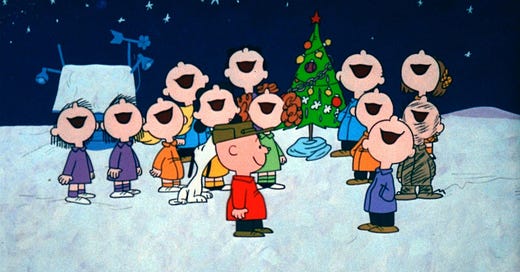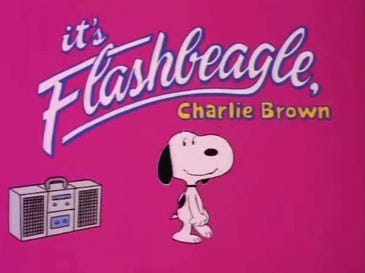“A Charlie Brown Christmas” Is a Miracle of Music Supervision
Sociopaths, depressives, and predators collide with a laid-back 60s jazz pianist—and a middling TV special transforms into the “Dark Side of the Moon" of holiday favorites.
The Peanuts characters are all horrible people.
Charlie Brown is a manic depressive buzzkill. Lucy is violent and sexually predatory while maintaining a side gig doling out psychiatric advice for a nickel. Linus clutches a trauma blanket and shakes like Danny Torrance from The Shining while reciting biblical passages to an empty auditorium. Snoopy is not “mercurial,” or “imaginative”—he’s an unrepentant sociopath who sells Charlie out time and again: When Charlie gets the opportunity to turn his life around and direct the school play, Snoopy actually boos him as he’s introduced to the cast. “Man’s best friend,” is all Chuck can muster, but I’ll say it: What an asshole.
Had that scraggly tree Charlie picked out been loved for what it was, we’d have had a “love thy neighbor”-style moral on our hands. But instead, the Peanuts gang (and let’s be clear—it’s a gang) loots Snoopy’s award-winning doghouse, tarts the tree up to look exactly like everything Charlie Brown bemoans, and presents it to him. But—get this—Charlie Brown loves it! Of course! Because the real moral is Negative Attention Is Better Than None at All, Charlie Brown.
As they join together in a wide-mouthed version of “Hark, the Herald Angels Sing,” any hope for a message is demolished. The ensemble resolves to conform, consume, and sing the pain away.
And yet the show never comes off the rails. In fact, it’s kind of beautiful, thanks to the counter-mood set by West Coast jazz pianist Vince Guaraldi, whose inclusion in the series is a true masterstroke in the history of music supervision. I don’t think it’s a stretch to place early Peanuts next to John Williams scores and the Goodfellas soundtrack: The marriage of sound and picture creates an emotional resonance that the script and its characters might not (um, do not) have otherwise. For a captive viewer like myself, it’s that resonance that keeps me from throwing my child’s dollhouse at the TV set.
“I want to write standards, not just hits” ~Vince Guaraldi
A Charlie Brown Christmas almost never made it to TV. The Peanuts comic strip was huge in the early 60s, but CBS passed on the pilot, feeling it was slow, choppy, and kind of weird—which it was, and still is. Coca-Cola stepped in to sponsor the show, and, shockingly, the 1965 debut came in second in the ratings behind Bonanza. Unlike Bonanza, however, the Vince Guaraldi soundtrack has entered the pantheon of holiday favorites.
A Charlie Brown Christmas has a strange tempo inherent within it: the child actors, for one, don’t sound like they actually know what they’re saying, so you can hear all kinds of cuts and edits in their dialogue. In part, it’s that endearing choppiness that Guaraldi’s trio smooths over. Sally’s almost incoherent line, “All I want is what I have coming to me. All I want is my fair share,” actually settles into normalcy when placed in Vince’s cool jazz context. Without the music, it would sound like she’s having a stroke. This same dynamic occurs throughout the 22-minute show: the music actually fixes problems simply by giving the scenes a groove.
Guaraldi’s interpretation of winter is as a sublime and meditative season, and it’s a true Californian who can maintain such a picturesque remove from the subject. In “Skating,” his right hand conjures falling snow, and in “Christmas Time Is Here” the elongated chords stretch across the bars like that frozen pond the kids are skating (and practically killing each other) on. He’s an impressionist that swings, Bill Evans with a smile, and in his playing he teases out the best qualities of Schroeder (skill), Linus (poetry), and Snoopy (cool). In our present, AutoTuned age, the conscious decision to keep an out-of-tune children’s choir on the soundtrack evokes empathy and collective nostalgia—we’ve all been in those wonky, imperfect school plays at some point in our lives. Even the crudely drawn animation swells into three-dimensionality against the ambient reverbs and acoustic room sounds achieved during recording.
“I don’t think I’m a great piano player” ~Vince Guaraldi
If you purchase A Charlie Brown Christmas off most streaming services, you also get, as a special bonus, 1992’s It’s Christmastime Again, Charlie Brown, which I’ve watched exactly once. In fact, subsequent specials only prove how desperately the Charlie Brown universe needs the alternate Guaraldi universe: There are porny 80s saxophones, transparent nods to cultural trends (the all-you-need-to-know title: It’s FlashBeagle, Charlie Brown), and an excruciating Peppermint Patty exercise video that reimagines Tony Basil’s “Hey Mickey.” Guaraldi is where the magic happens, and without him, the storylines and music choices clash like a body rejecting an artificial heart.
Never mind the other holiday specials, and watch A Charlie Brown Christmas. With Vince at the wheel, winter is rumination, the kids are forgivable, and the show itself is a gentle, intimate, even private, experience. More than any character, it’s Guaraldi who conjures it all while poking a hopeful ray of Northern California sunshine into an otherwise bleak, barely benign version of Lord of the Flies.
You’re a good man, Vince Guaraldi.
Author’s note: I'm dropping the monthly sub to $5/month. I'd love you to get a paid sub, and I don't want to paywall anything, and I also want to price it to make it work for you. If you’re not into it, you can always buy me a coffee: https://buymeacoffee.com/mikeerrico









I love the insights in Mike's post. I got to know Lee Mendelson, the producer of the Peanuts shows, a few years before he passed away. He was credited with writing the lyrics on "Christmas Time is Here." I remember asking him about his choice of Vince Guaraldi for the music. He told me that he loved jazz, and that he knew the music would have to do a lot to hold together the mood and story line. He didn't elaborate, but I think Mike just did.